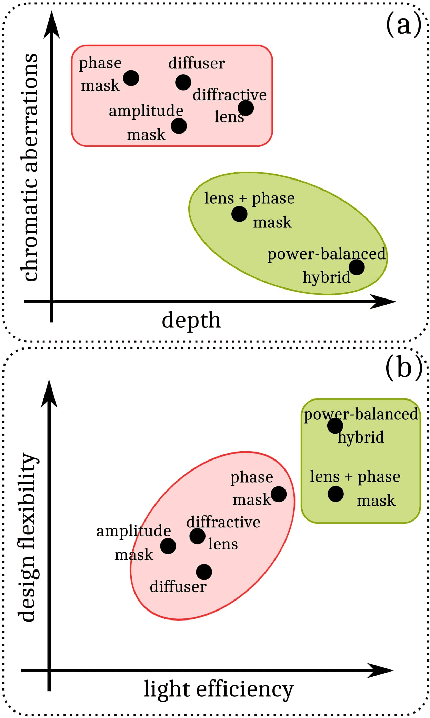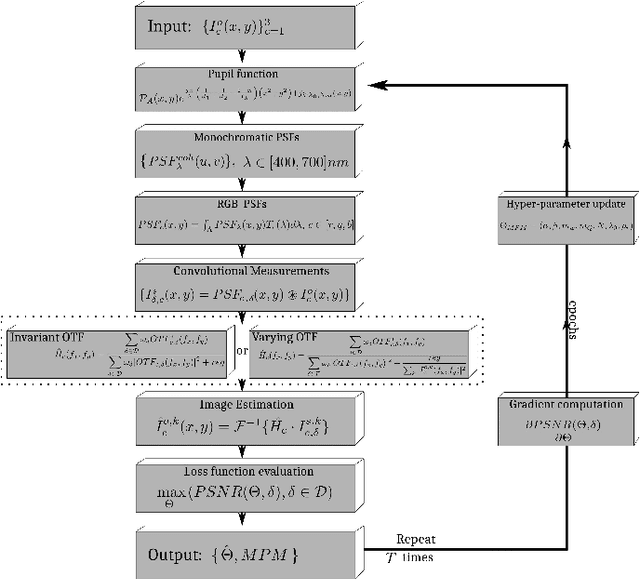Seyyed Reza Miri Rostami
Hybrid Diffractive Optics Design via Hardware-in-the-Loop Methodology for Achromatic Extended-Depth-of-Field Imaging
Mar 30, 2022



Abstract:End-to-end optimization of diffractive optical elements (DOEs) profile through a digital differentiable model combined with computational imaging have gained an increasing attention in emerging applications due to the compactness of resultant physical setups. Despite recent works have shown the potential of this methodology to design optics, its performance in physical setups is still limited and affected by manufacturing artifacts of DOE, mismatch between simulated and resultant experimental point spread functions, and calibration errors. Additionally, the computational burden of the digital differentiable model to effectively design the DOE is increasing, thus limiting the size of the DOE that can be designed. To overcome the above mentioned limitations, the broadband imaging system with phase-only spatial light modulator (SLM) as an encoded DOE is proposed and developed in this paper. A co-design of the SLM phase pattern and image reconstruction algorithm is produced following the end-to-end strategy, using for optimization a convolutional neural network equipped with quantitative and qualitative loss functions. The optics of the imaging system is hybrid consisting of SLM as DOE and refractive lens. SLM phase-pattern is optimized by applying the Hardware-in-the-loop technique, which helps to eliminate the mismatch between numerical modeling and physical reality of image formation as light propagation is not numerically modeled but is physically done. In our experiments, the hybrid optics is implemented by the optical projection of the SLM phase-pattern on a lens plane for a depth range 0.4-1.9m. Comparison with compound multi-lens optics such as Sony A7 III and iPhone Xs Max cameras show that the proposed system is advanced in all-in-focus sharp imaging.
Optimized Power-Balanced Hybrid Phase-Coded Optics and Inverse Imaging for Achromatic EDoF
Mar 09, 2021



Abstract:The power-balanced hybrid optical imaging system is a special design of a computational camera, introduced in this paper, with image formation by a refractive lens and Multilevel Phase Mask (MPM) as a diffractive optical element (DoE). This system provides a long focal depth and low chromatic aberrations thanks to MPM, and a high energy light concentration due to the refractive lens. This paper additionally introduces the concept of a optimal power balance between lens and MPM for achromatic extended-depth-of-field (EDoF) imaging. To optimize this power-balance as well as to optimize MPM using Neural Network techniques, we build a fully-differentiable image formation model for joint optimization of optical and imaging parameters for the designed computational camera. Additionally, we determine a Wiener-like inverse imaging optimal optical transfer function (OTF) to reconstruct a sharp image from the defocused observation. We numerically and experimentally compare the designed system with its counterparts, lensless and just-lens optical systems, for the visible wavelength interval (400-700) nm and the EDoF range (0.5-1000) m. The attained results demonstrate that the proposed system equipped with the optimal OTF overcomes its lensless and just-lens counterparts (even when they are used with optimized OTFs) in terms of reconstruction quality for off-focus distances.
 Add to Chrome
Add to Chrome Add to Firefox
Add to Firefox Add to Edge
Add to Edge